Application of the Random Forest Classifier to Map Irrigated Areas Using Google Earth Engine
Abstract
1. Introduction
2. Methods
2.1. Description of the Study Area
2.2. Methodological Framework
2.3. Data Sources
2.4. The Random Forest Algorithm
2.4.1. Landcover Classes and Reference Data
2.4.2. Crop Phenology Derivation from NDVI
2.5. NDVI Trend Analysis over Cultivated Land
2.6. Distinguishing Irrigated from Rainfed Areas
3. Results and Discussion
3.1. Cultivated Areas of Mpumalanga Province
3.2. Accuracy Assessment
3.3. Separating Irrigated from Rainfed Areas
3.4. Changes in the Irrigated Area between 2019 and 2020
3.5. Pros and Cons of Using the Random Forest in Land Use Classification
4. Conclusions
Supplementary Materials
Author Contributions
Funding
Institutional Review Board Statement
Informed Consent Statement
Data Availability Statement
Acknowledgments
Conflicts of Interest
References
- Kuil, L.; Carr, G.; Prskawetz, A.; Salinas, J.L.; Viglione, A.; Blöschl, G. Learning from the Ancient Maya: Exploring the Impact of Drought on Population Dynamics. Ecol. Econ. 2019, 157, 1–16. [Google Scholar] [CrossRef]
- Tian, J.; Bryksa, B.C.; Yada, R.Y. Feeding the world into the future–food and nutrition security: The role of food sci-ence and technology. Front. Life Sci. 2016, 9, 155–166. [Google Scholar] [CrossRef]
- Nhamo, L.; Mathcaya, G.; Mabhaudhi, T.; Nhlengethwa, S.; Nhemachena, C.; Mpandeli, S. Cereal Production Trends under Climate Change: Impacts and Adaptation Strategies in Southern Africa. Agriculture 2019, 9, 30. [Google Scholar] [CrossRef]
- Cosgrove, W.J.; Loucks, D.P. Water management: Current and future challenges and research directions. Water Resour. Res. 2015, 51, 4823–4839. [Google Scholar] [CrossRef]
- Mo, X.-G.; Hu, S.; Lin, Z.-H.; Liu, S.-X.; Xia, J. Impacts of climate change on agricultural water resources and adaptation on the North China Plain. Adv. Clim. Chang. Res. 2017, 8, 93–98. [Google Scholar] [CrossRef]
- Cai, X.; Magidi, J.; Nhamo, L.; van Koppen, B. Mapping Irrigated Areas in the Limpopo Province, South Africa; 9290908513; International Water Management Institute (IWMI): Colombo, Sri Lanka, 2017; p. 42. [Google Scholar]
- Nhemachena, C.; Nhamo, L.; Matchaya, G.; Nhemachena, C.R.; Muchara, B.; Karuaihe, S.T.; Mpandeli, S. Climate Change Impacts on Water and Agriculture Sectors in Southern Africa: Threats and Opportunities for Sustainable Development. Water 2020, 12, 2673. [Google Scholar] [CrossRef]
- Mancosu, N.; Snyder, R.L.; Kyriakakis, G.; Spano, D. Water Scarcity and Future Challenges for Food Production. Water 2015, 7, 975–992. [Google Scholar] [CrossRef]
- Teluguntla, P.; Thenkabail, P.; Oliphant, A.; Xiong, J.; Gumma, M.K.; Congalton, R.G.; Yadav, K.; Huete, A. A 30-m landsat-derived cropland extent product of Australia and China using random forest machine learning algorithm on Google Earth Engine cloud computing platform. ISPRS J. Photogramm. Remote. Sens. 2018, 144, 325–340. [Google Scholar] [CrossRef]
- Mpandeli, S.; Nhamo, L.; Moeletsi, M.; Masupha, T.; Magidi, J.; Tshikolomo, K.; Liphadzi, S.; Naidoo, D.; Mabhaudhi, T. Assessing climate change and adaptive capacity at local scale using observed and remotely sensed data. Weather. Clim. Extrem. 2019, 26, 100240. [Google Scholar] [CrossRef]
- Meier, J.; Zabel, F.; Mauser, W. A global approach to estimate irrigated areas—A comparison between different data and statistics. Hydrol. Earth Syst. Sci. 2018, 22, 1119–1133. [Google Scholar] [CrossRef]
- Angelakιs, A.N.; Zaccaria, D.; Krasilnikoff, J.; Salgot, M.; Bazza, M.; Roccaro, P.; Jimenez, B.; Kumar, A.; Yinghua, W.; Baba, A.; et al. Irrigation of World Agricultural Lands: Evolution through the Millennia. Water 2020, 12, 1285. [Google Scholar] [CrossRef]
- Siddiqui, S.; Cai, X.; Chandrasekharan, K. Irrigated Area Map Asia and Africa (International Water Management Institute; International Water Management Institute (IWMI): Colombo, Sri Lanka, 2016. [Google Scholar]
- Siebert, S.; Henrich, V.; Frenken, K.; Burke, J. Update of the Digital Global Map of Irrigation Areas to Version 5; Food and Agriculture Organization of the United Nations (FAO): Rome, Italy, 2013; p. 117. [Google Scholar]
- Siebert, S.; Kummu, M.; Porkka, M.; Döll, P.; Ramankutty, N.; Scanlon, B.R. A global data set of the extent of irri-gated land from 1900 to 2005. Hydrol. Earth Syst. Sci. 2015, 19, 1521–1545. [Google Scholar] [CrossRef]
- Portmann, F.T.; Siebert, S.; Döll, P. MIRCA2000-Global monthly irrigated and rainfed crop areas around the year 2000: A new high-resolution data set for agricultural and hydrological modeling. Glob. Biogeochem. Cycles 2010, 24, 24. [Google Scholar] [CrossRef]
- Thenkabail, P.; GangadharaRao, P.; Biggs, T.; Krishna, M.; Turral, H. Spectral matching techniques to determine historical land-use/land-cover (LULC) and irrigated areas using time-series 0.1-degree AVHRR pathfinder datasets. Photogramm. Eng. Remote. Sens. 2007, 73, 1029–1040. [Google Scholar]
- Nhamo, L.; Magidi, J.; Nyamugama, A.; Clulow, A.D.; Sibanda, M.; Chimonyo, V.G.P.; Mabhaudhi, T. Prospects of Improving Agricultural and Water Productivity through Unmanned Aerial Vehicles. Agriculture 2020, 10, 256. [Google Scholar] [CrossRef]
- Amani, M.; Ghorbanian, A.; Ahmadi, S.A.; Kakooei, M.; Moghimi, A.; MirMazloumi, S.M.; Moghaddam, S.H.A.; Mahdavi, S.; Ghahremanloo, M.; Parsian, S.; et al. Google Earth Engine Cloud Computing Platform for Remote Sensing Big Data Applications: A Comprehensive Review. IEEE J. Sel. Top. Appl. Earth Obs. Remote. Sens. 2020, 13, 5326–5350. [Google Scholar] [CrossRef]
- Xiong, J.; Thenkabail, P.S.; Tilton, J.C.; Gumma, M.K.; Teluguntla, P.; Oliphant, A.; Congalton, R.G.; Yadav, K.; Gorelick, N. Nominal 30-m Cropland Extent Map of Continental Africa by Integrating Pixel-Based and Object-Based Algorithms Using Sentinel-2 and Landsat-8 Data on Google Earth Engine. Remote. Sens. 2017, 9, 1065. [Google Scholar] [CrossRef]
- Basukala, A.K.; Oldenburg, C.; Schellberg, J.; Sultanov, M.; Dubovyk, O. Towards improved land use mapping of irrigated croplands: Performance assessment of different image classification algorithms and approaches. Eur. J. Remote. Sens. 2017, 50, 187–201. [Google Scholar] [CrossRef]
- Nhamo, L.; Van Dijk, R.; Magidi, J.; Wiberg, D.; Tshikolomo, K. Improving the accuracy of remotely sensed irrigated areas using post-classification enhancement through UAV capability. Remote. Sens. 2018, 10, 712. [Google Scholar] [CrossRef]
- Abdi, A.M. Land cover and land use classification performance of machine learning algorithms in a boreal land-scape using Sentinel-2 data. GISci. Remote. Sens. 2020, 57, 1–20. [Google Scholar] [CrossRef]
- Du Plessis, A. Current Water Quality Risk Areas for Limpopo, Olifants and the Inkomati-Usuthu WMAs. In Water as an Inescapable Risk; Springer: Berlin/Heidelberg, Germany, 2019; pp. 183–212. [Google Scholar]
- Denby, K.; Movik, S.; Mehta, L.; van Koppen, B. The’trickle down’of IWRM: A case study of local-level realities in the Inkomati Water Management Area, South Africa. Water Alternatives 2016, 9, 473–492. [Google Scholar]
- Riddell, E.S.; Govender, D.; Botha, J.; Sithole, H.; Petersen, R.M.; Shikwambana, P. Pollution impacts on the aquatic ecosystems of the Kruger National Park, South Africa. Sci. Afr. 2019, 6, 00195. [Google Scholar] [CrossRef]
- Gorelick, N.; Hancher, M.; Dixon, M.; Ilyushchenko, S.; Thau, D.; Moore, R. Google Earth Engine: Planetary-scale geospatial analysis for everyone. Remote. Sens. Environ. 2017, 202, 18–27. [Google Scholar] [CrossRef]
- Sheykhmousa, M.; Mahdianpari, M.; Ghanbari, H.; Mohammadimanesh, F.; Ghamisi, P.; Homayouni, S. Support Vector Machine vs. Random Forest for Remote Sensing Image Classification: A Meta-analysis and systematic review. IEEE J. Sel. Top. Appl. Earth Obs. Remote. Sens. 2020, 13, 18. [Google Scholar] [CrossRef]
- Berhane, T.M.; Lane, C.R.; Wu, Q.; Autrey, B.C.; Anenkhonov, O.A.; Chepinoga, V.V.; Liu, H. Decision-Tree, Rule-Based, and Random Forest Classification of High-Resolution Multispectral Imagery for Wetland Mapping and Inventory. Remote. Sens. 2018, 10, 580. [Google Scholar] [CrossRef]
- CEC. Field Crop Boundary Data Layer 2019; Crop Estimates Consortium (CEC), Department of Agriculture, Land Reform and Rural Development (DALRRD): Pretoria, South Africa, 2019; Volume 2019. [Google Scholar]
- GTI. 2013–2014 South African National Land-Cover Dataset: Data User Report and Metadata; GeoTerraImage (GTI), Department of Environmental Affairs (DEA): Pretoria, South Africa, 2015. [Google Scholar]
- Breiman, L. Random forests. Mach. Learn. 2001, 45, 5–32. [Google Scholar] [CrossRef]
- Zeferino, L.B.; De Souza, L.F.T.; Amaral, C.H.D.; Filho, E.I.F.; De Oliveira, T.S. Does environmental data increase the accuracy of land use and land cover classification? Int. J. Appl. Earth Obs. Geoinf. 2020, 91, 102128. [Google Scholar] [CrossRef]
- Toosi, N.B.; Soffianian, A.R.; Fakheran, S.; Pourmanafi, S.; Ginzler, C.; Waser, L.T. Comparing different classifica-tion algorithms for monitoring mangrove cover changes in southern Iran. Glob. Ecol. Conserv. 2019, 19, e00662. [Google Scholar] [CrossRef]
- Hatwell, J.; Gaber, M.M.; Azad, R.M.A. CHIRPS: Explaining random forest classification. Artif. Intell. Rev. 2020, 53, 5747–5788. [Google Scholar] [CrossRef]
- Schmidt, J.; Marques, M.R.; Botti, S.; Marques, M.A. Recent advances and applications of machine learning in solid-state materials science. NPJ Comput. Mater. 2019, 5, 1–36. [Google Scholar] [CrossRef]
- Da Silva, V.S.; Salami, G.; Da Silva, M.I.O.; Silva, E.A.; Junior, J.J.M.; Alba, E. Methodological evaluation of vegetation indexes in land use and land cover (LULC) classification. Geol. Ecol. Landsc. 2019, 4, 159–169. [Google Scholar] [CrossRef]
- Nhamo, L.; Ebrahim, G.Y.; Mabhaudhi, T.; Mpandeli, S.; Magombeyi, M.; Chitakira, M.; Magidi, J.; Sibanda, M. An assessment of groundwater use in irrigated agriculture using multi-spectral remote sensing. Phys. Chem. Earth, Parts A/B/C 2020, 115, 102810. [Google Scholar] [CrossRef]
- Hoare, D.; Frost, P. Phenological description of natural vegetation in southern Africa using remotely-sensed vegetation data. Appl. Veg. Sci. 2004, 7, 19–28. [Google Scholar] [CrossRef]
- Ambika, A.K.; Wardlow, B.; Mishra, V. Remotely sensed high resolution irrigated area mapping in India for 2000 to 2015. Sci. Data 2016, 3, 160118. [Google Scholar] [CrossRef]
- Sujariya, S.; Jongrungklang, N.; Jongdee, B.; Inthavong, T.; Budhaboon, C.; Fukai, S. Rainfall variability and its ef-fects on growing period and grain yield for rainfed lowland rice under transplanting system in Northeast Thailand. Plant Prod. Sci. 2020, 23, 48–59. [Google Scholar] [CrossRef]
- Adole, T.; Dash, J.; Atkinson, P.M. Large-scale prerain vegetation green-up across Africa. Glob. Chang. Biol. 2018, 24, 4054–4068. [Google Scholar] [CrossRef] [PubMed]
- Lee, K.; Kim, K.; Lee, S.-G.; Kim, Y. Determination of the Normalized Difference Vegetation Index (NDVI) with Top-of-Canopy (TOC) Reflectance from a KOMPSAT-3A Image Using Orfeo ToolBox (OTB) Extension. ISPRS Int. J. Geo-Inf. 2020, 9, 257. [Google Scholar] [CrossRef]
- StatsSA. Statistics South Africa Releases Census of Commercial Agriculture 2017 Report; Statistics South Africa (StatsSA): Pretoria, South Africa, 2020. [Google Scholar]
- NDP. National Development Plan: Vision 2030; National Planning Commission (NDP): Pretoria, South Africa, 2013; p. 489. [Google Scholar]
- Van Averbeke, W.; Denison, J.; Mnkeni, P. Smallholder irrigation schemes in South Africa: A review of knowledge generated by the Water Research Commission. Water SA 2011, 37, 797–808. [Google Scholar] [CrossRef]
- Fanadzo, M.; Ncube, B. Challenges and opportunities for revitalising smallholder irrigation schemes in South Africa. Water SA 2018, 44, 436–447. [Google Scholar] [CrossRef]
- Vanschoenwinkel, J.; Van Passel, S. Climate response of rainfed versus irrigated farms: The bias of farm heteroge-neity in irrigation. Clim. Chang. 2018, 147, 225–234. [Google Scholar] [CrossRef]
- Nhamo, L.; Mabhaudhi, T.; Magombeyi, M. Improving Water Sustainability and Food Security through Increased Crop Water Productivity in Malawi. Water 2016, 8, 411. [Google Scholar] [CrossRef]
- Mabhaudhi, T.; Mpandeli, S.; Nhamo, L.; Chimonyo, V.G.P.; Senzanje, A.; Naidoo, D.; Liphadzi, S.; Modi, A.T. Emerging Water-Energy-Food Nexus Lessons, Experiences, and Opportunities in Southern Africa. In Environmental Management of Air, Water, Agriculture, and Energy; CRC Press: Boca Raton, FL, USA, 2020; pp. 141–158. [Google Scholar]
- Mabhaudhi, T.; Mpandeli, S.; Nhamo, L.; Chimonyo, V.G.P.; Nhemachena, C.; Senzanje, A.; Naidoo, D.; Modi, A.T. Prospects for Improving Irrigated Agriculture in Southern Africa: Linking Water, Energy and Food. Water 2018, 10, 1881. [Google Scholar] [CrossRef]
- Mpandeli, S.; Naidoo, D.; Mabhaudhi, T.; Nhemachena, C.; Nhamo, L.; Liphadzi, S.; Hlahla, S.; Modi, A.T. Climate Change Adaptation through the Water-Energy-Food Nexus in Southern Africa. Int. J. Environ. Res. Public Health 2018, 15, 2306. [Google Scholar] [CrossRef] [PubMed]
- Nhamo, L.; Ndlela, B. Nexus planning as a pathway towards sustainable environmental and human health post Covid-19. Environ. Res. 2021, 192, 110376. [Google Scholar] [CrossRef] [PubMed]
- Nhamo, L.; Ndlela, B.; Nhemachena, C.; Mabhaudhi, T.; Mpandeli, S.; Matchaya, G. The Water-Energy-Food Nexus: Climate Risks and Opportunities in Southern Africa. Water 2018, 10, 567. [Google Scholar] [CrossRef]
- Nhamo, L.; Mabhaudhi, T.; Mpandeli, S.; Dickens, C.; Nhemachena, C.; Senzanje, A.; Naidoo, D.; Liphadzi, S.; Modi, A.T. An integrative analytical model for the water-energy-food nexus: South Africa case study. Environ. Sci. Policy 2020, 109, 15–24. [Google Scholar] [CrossRef]
- Gudmann, A.; Csikós, N.; Szilassi, P.; Mucsi, L. Improvement in Satellite Image-Based Land Cover Classification with Landscape Metrics. Remote. Sens. 2020, 12, 3580. [Google Scholar] [CrossRef]
- Jin, Y.; Liu, X.; Chen, Y.; Liang, X. Land-cover mapping using Random Forest classification and incorporating NDVI time-series and texture: A case study of central Shandong. Int. J. Remote. Sens. 2018, 39, 8703–8723. [Google Scholar] [CrossRef]
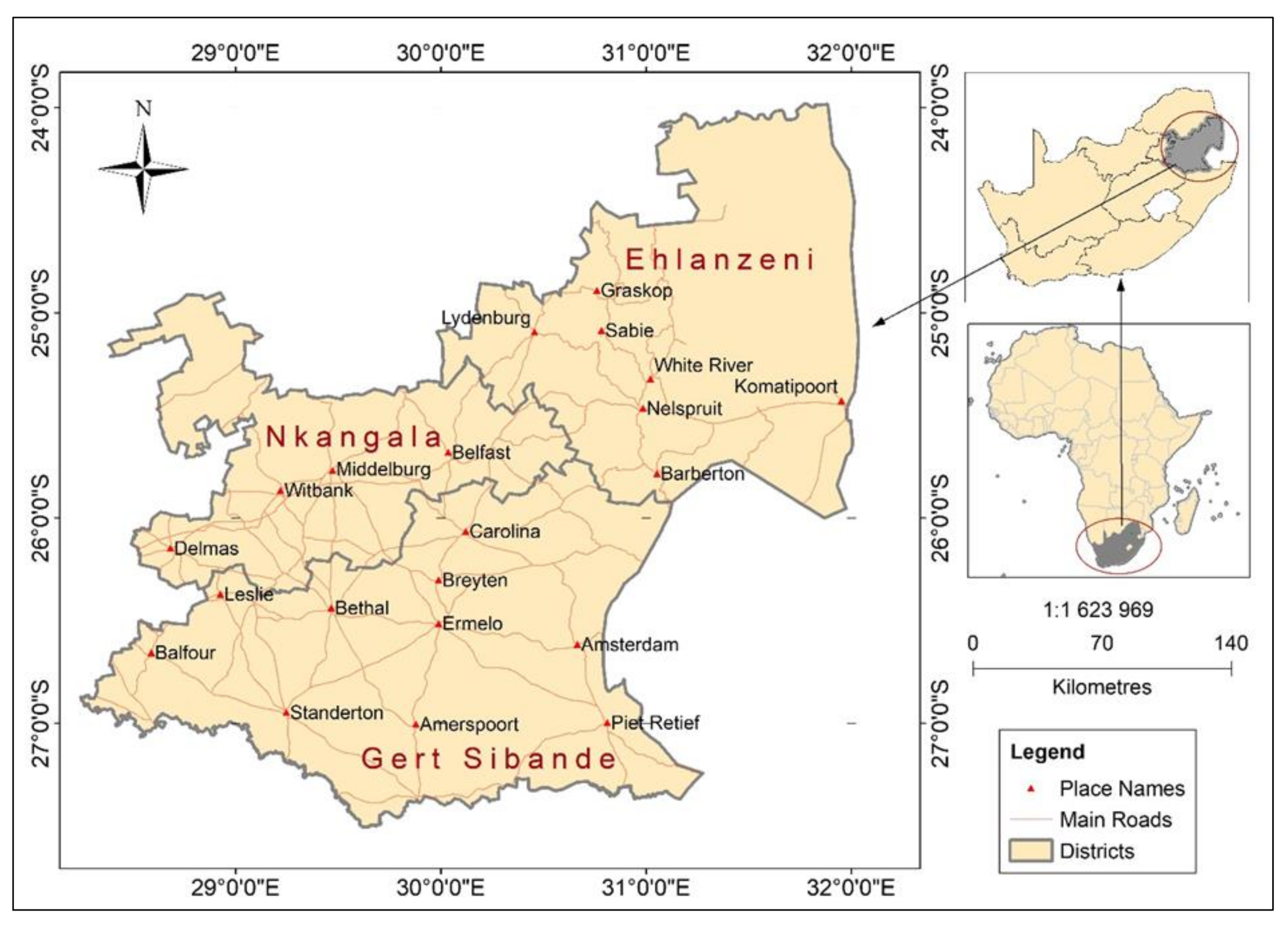
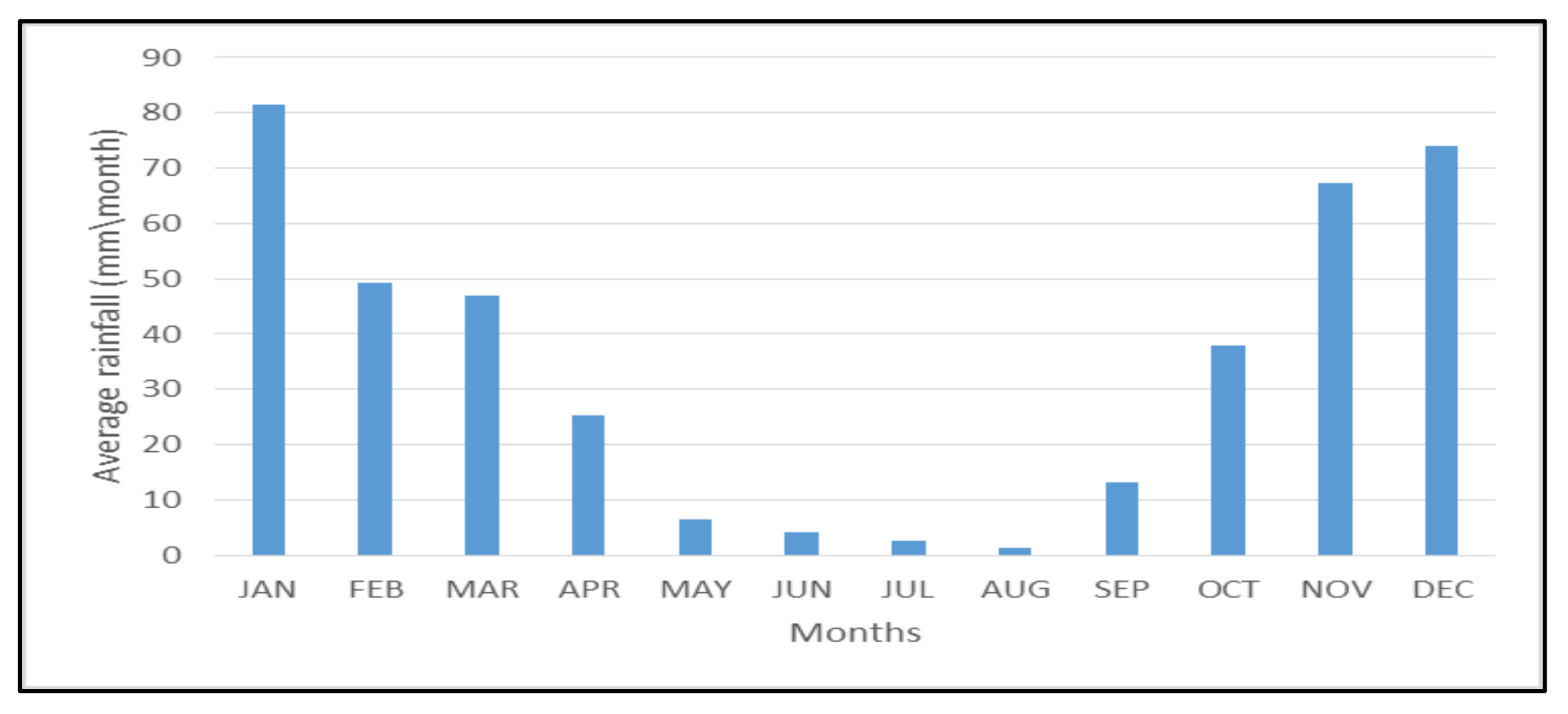

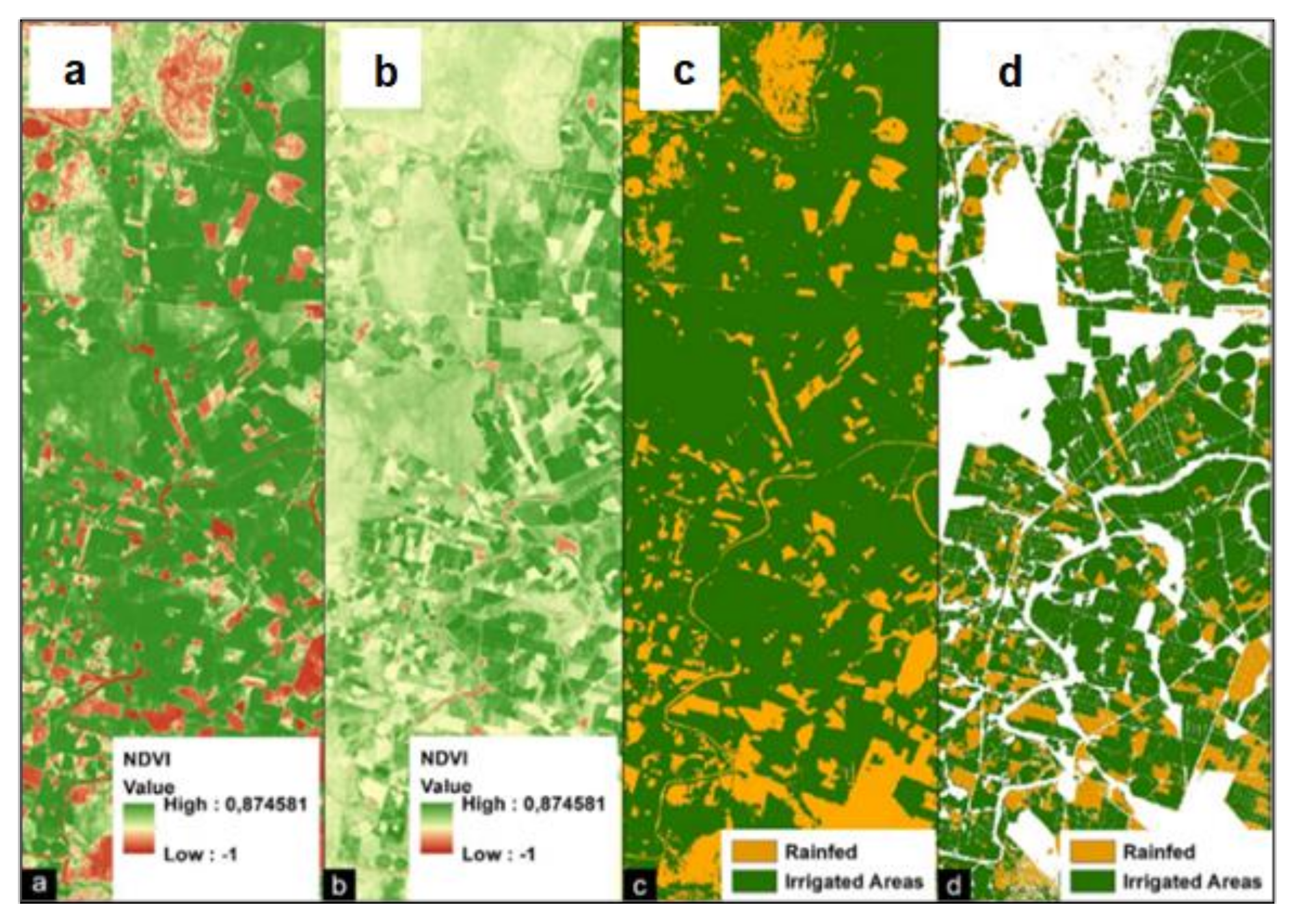

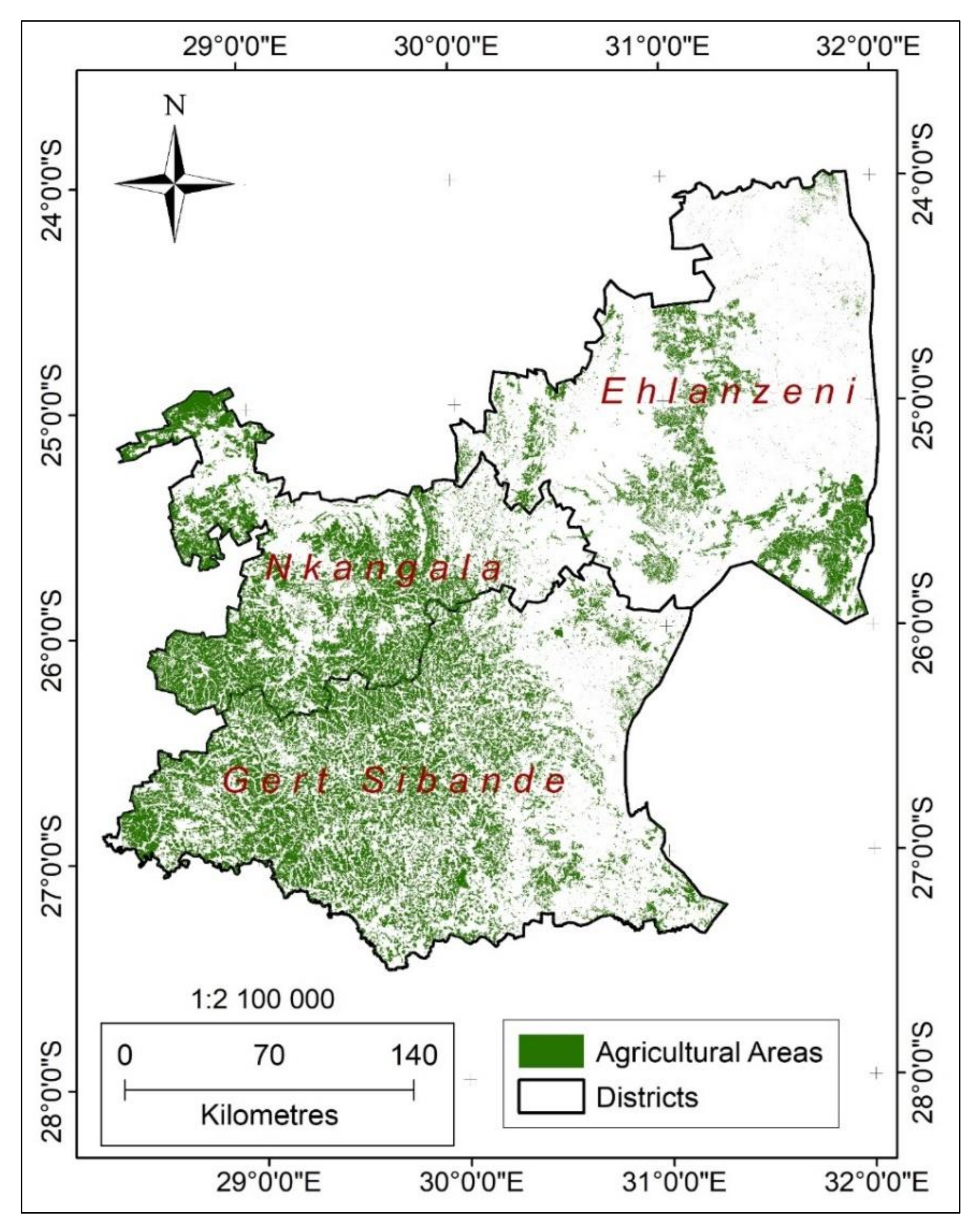
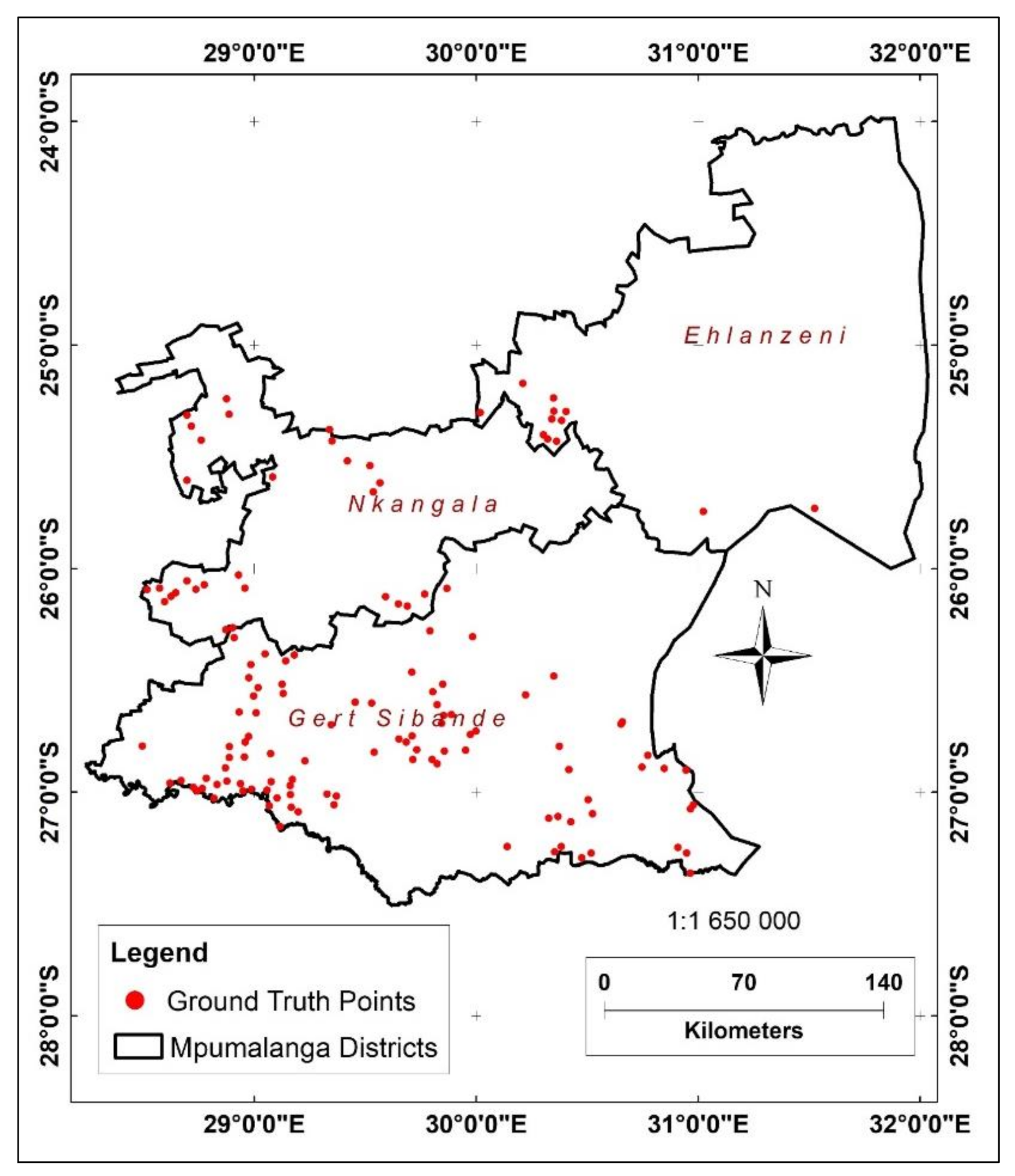

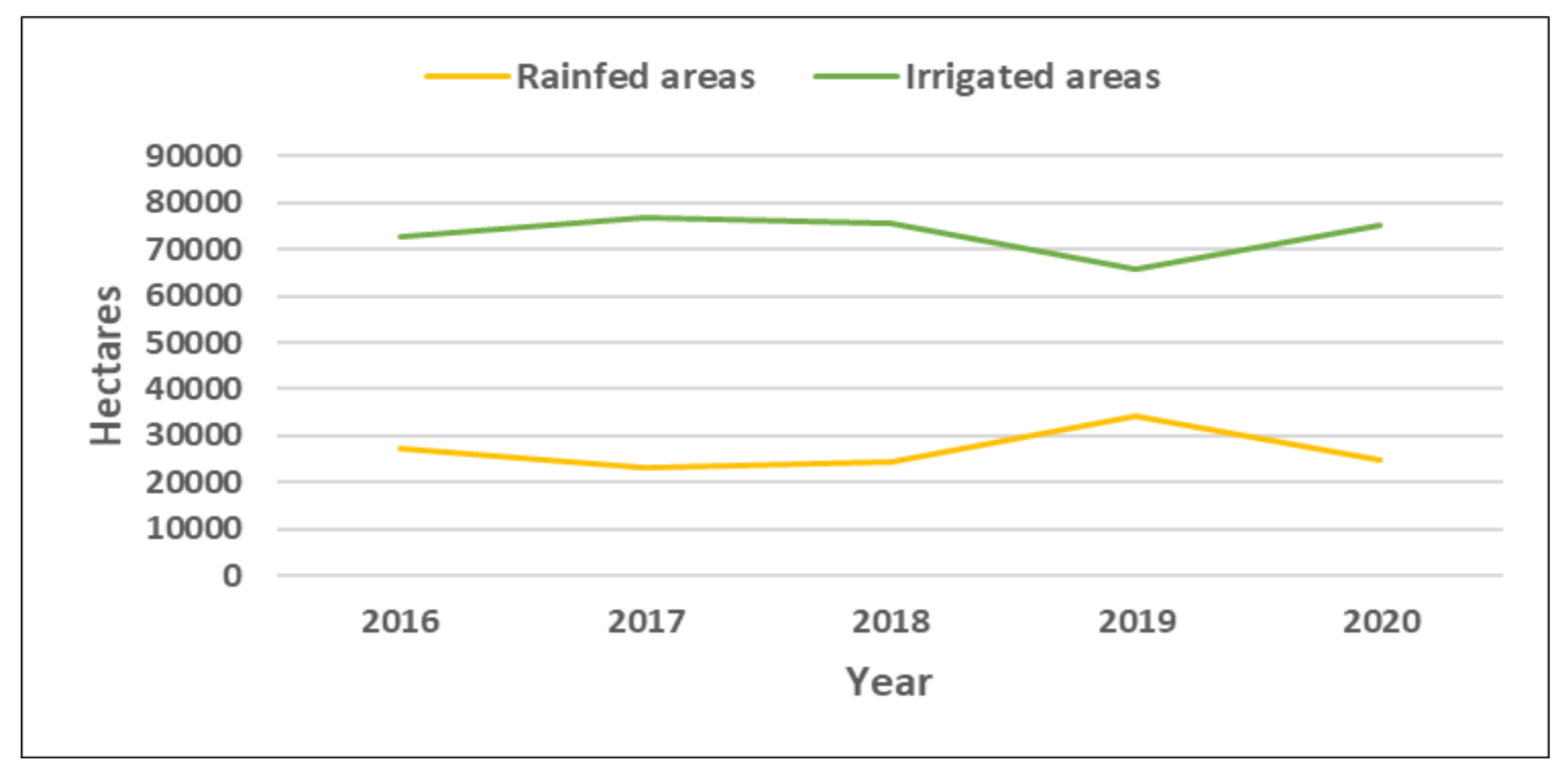
| Land Classification | Description |
|---|---|
| Cultivated land | Land planted with crops, newly opened cropped areas, fallow land |
| Natural vegetation | Shrublands, forested lands, grasslands, natural or planted forests |
| Water | All water bodies, including rivers, wetlands, reservoirs, etc |
| Built-up area | All settlements, including industrial areas |
| District | Area (ha) | Rainfed Area (ha) | Irrigated Area (ha) | Cultivated Area (ha) | Rainfed Area (%) | Irrigated Areas (%) | Cultivated Area (%) |
|---|---|---|---|---|---|---|---|
| 2020 | |||||||
| Gert Sibande | 3,189,239.14 | 284,963.35 | 756,614.12 | 1,041,577.47 | 27.36 | 72.64 | 32.66 |
| Nkangala | 1,679,938.90 | 201,492.75 | 445,151.50 | 646,644.25 | 31.16 | 68.84 | 38.49 |
| Ehlanzeni | 2,789,686.33 | 22,592.30 | 326,176.48 | 348,768.78 | 6.48 | 93.52 | 12.50 |
| Mpumalanga | 7,658,864.36 | 509,048.40 | 1,527,942.10 | 2,036,990.50 | 24.99 | 75.01 | 26.60 |
| 2019 | |||||||
| Gert Sibande | 3,189,239.14 | 352,240.02 | 689,337.45 | 1,041,577.47 | 33.82 | 66.18 | 32.66 |
| Nkangala | 1,679,938.90 | 288,002.67 | 358,641.59 | 646,644.25 | 44.54 | 55.46 | 38.49 |
| Ehlanzeni | 2,789,686.33 | 54,785.44 | 293,983.34 | 348,768.78 | 15.71 | 84.29 | 12.50 |
| Mpumalanga | 7,658,864.36 | 695,028.12 | 1,341,962.38 | 2,036,990.50 | 34.12 | 65.88 | 26.60 |
| 2019 | 2020 | % Change | |
|---|---|---|---|
| Rainfed areas (ha) | 695,028.12 | 509,048.40 | −36.53 |
| Irrigated areas (ha) | 1,341,962.38 | 1,527,942.10 | 12.176 |
| Total cultivated areas (ha) | 2,036,990.50 | 2,036,990.50 |
Publisher’s Note: MDPI stays neutral with regard to jurisdictional claims in published maps and institutional affiliations. |
© 2021 by the authors. Licensee MDPI, Basel, Switzerland. This article is an open access article distributed under the terms and conditions of the Creative Commons Attribution (CC BY) license (http://creativecommons.org/licenses/by/4.0/).
Share and Cite
Magidi, J.; Nhamo, L.; Mpandeli, S.; Mabhaudhi, T. Application of the Random Forest Classifier to Map Irrigated Areas Using Google Earth Engine. Remote Sens. 2021, 13, 876. https://doi.org/10.3390/rs13050876
Magidi J, Nhamo L, Mpandeli S, Mabhaudhi T. Application of the Random Forest Classifier to Map Irrigated Areas Using Google Earth Engine. Remote Sensing. 2021; 13(5):876. https://doi.org/10.3390/rs13050876
Chicago/Turabian StyleMagidi, James, Luxon Nhamo, Sylvester Mpandeli, and Tafadzwanashe Mabhaudhi. 2021. "Application of the Random Forest Classifier to Map Irrigated Areas Using Google Earth Engine" Remote Sensing 13, no. 5: 876. https://doi.org/10.3390/rs13050876
APA StyleMagidi, J., Nhamo, L., Mpandeli, S., & Mabhaudhi, T. (2021). Application of the Random Forest Classifier to Map Irrigated Areas Using Google Earth Engine. Remote Sensing, 13(5), 876. https://doi.org/10.3390/rs13050876








